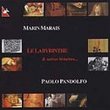| All Artists: Johann Sebastian Bach, Paolo Pandolfo Title: Bach: The Six Suites Members Wishing: 0 Total Copies: 0 Label: Glossa Release Date: 9/25/2001 Album Type: Import Genres: Dance & Electronic, Special Interest, Classical Styles: Chamber Music, Historical Periods, Baroque (c.1600-1750), Classical (c.1770-1830), Instruments, Strings Number of Discs: 2 SwapaCD Credits: 2 UPC: 675754416126 |
Search - Johann Sebastian Bach, Paolo Pandolfo :: Bach: The Six Suites
 | Johann Sebastian Bach, Paolo Pandolfo Bach: The Six Suites Genres: Dance & Electronic, Special Interest, Classical
|
Larger Image |
CD DetailsSimilar CDs |
CD ReviewsA very interesting take on the Bach Cello Suites. Bob Zeidler | Charlton, MA United States | 08/10/2002 (5 out of 5 stars) "Johann Sebastian Bach wrote, arguably (or perhaps not even open to argument), some of the most sublime music for the principal solo instruments (keyboards, violin, cello) of all time. Certain of these works, as I've written elsewhere, are true "cornerstones of Western art": The Goldberg Variations (for keyboards), the Sonatas and Partitas for Solo Violin, and the Suites for Solo Cello. Most lovers of this music have two or more (or several) versions of each. Sometimes (as in the case of the keyboard works), the justification for multiple versions is that the work(s) may be heard on multiple (and different) instruments, such as harpsichord and piano, where the differences between instruments are obvious. On the other hand, the differences between a modern violin and its Baroque counterpart are somewhat more subtle: The use of metal - rather than gut - strings, and differences in bow and bridge design and violin construction, add up to differences in brilliance of sound. The differences between the cello and the viola da gamba ("leg viol") lie somewhere in the middle of these extremes. Technically, the viola da gamba has six strings (all of gut) instead of four, the fingerboard has frets (as on a guitar or lute), the bridge is flatter (and closer to the fingerboard), and there is no foot peg. As a result, its sound is quite a bit brighter and less "assertive" than that of the cello. Its role is largely in the performance of music written for it (beginning with Renaissance music). Bach did not write his Suites for this instrument, but for its successor, the cello. Then why did Paolo Pandolfo transcribe and perform the Cello Suites for viola da gamba, and why should we be listening to them? In a phrase or two, because the nature of the instrument naturally highlights the "dance" origin of Bach's music, and because its transparency allows one to hear a good part of the implied counterpoint that can sometimes be obscured by the darker, more solemn tone of the cello. And pizzicato ("plucked") notes can sound almost lute-like, as they do in the Sarabande of the 4th Suite. This album is more than a mere technical tour de force (although it is that, given the sonic, construction, and technique differences between the two instruments). It is a very viable alternative (or perhaps addition) to the available cello performances. This new acquisition to my existing versions by Casals, Rostropovich and Starker on cello and Edgar Meyer on double bass (for only three of the six suites so far) is a welcome addition. It is "different." But it is also very, very good. The nicely-packaged album has, in addition to a booklet on the works, the performance and the artist, an additional booklet containing an imagined dialogue between a viol and a cello regarding the appropriateness of the instruments for these works. "Imagined" by Pandolfo, it is nicely whimsical. Bob Zeidler" Mighty personality. Bob Zeidler | 11/26/2001 (5 out of 5 stars) "I really think that this work was meant to be played on the
cello,but the sheer personality of Paolo Pandolfo make you forget all this and take you by the hand on this magnificent voyage. He is the best gamba player to date. The presentation of this disc is superb." |

 Track Listings (3) - Disc #1
Track Listings (3) - Disc #1


